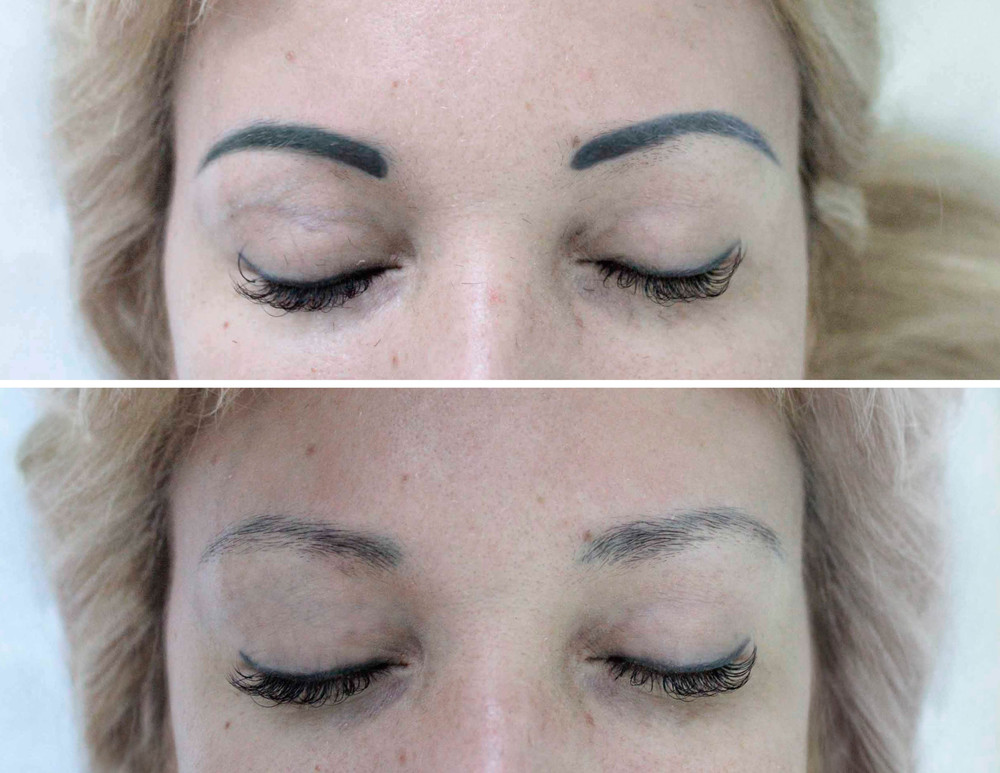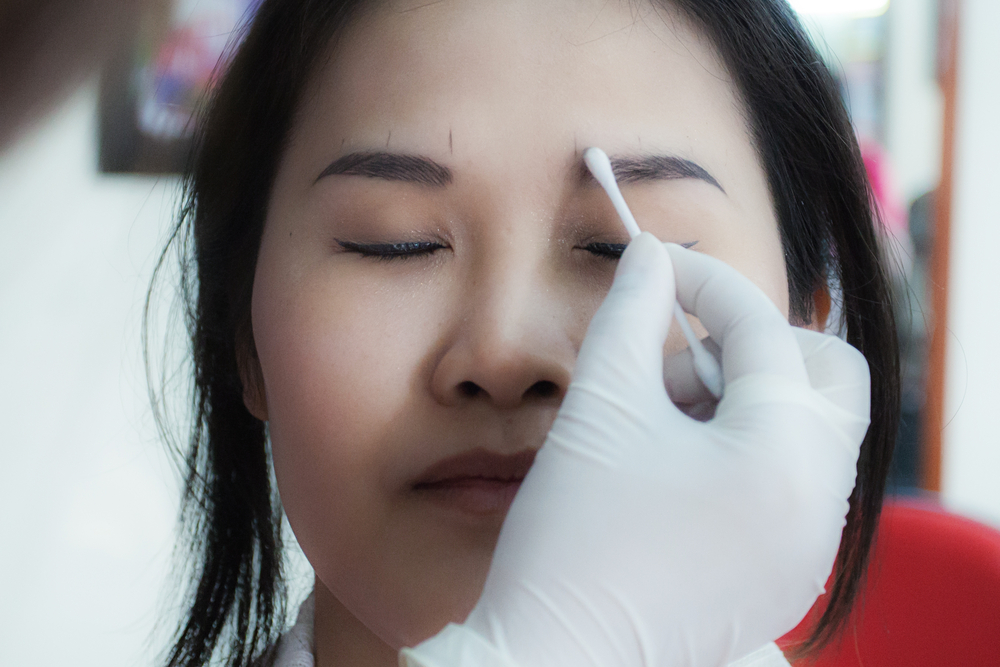In the realm of cosmetic procedures, eyebrow tattoos are sought-after method for achieving fuller, well-defined brows. But what happens when the results doesn’t meet expectations or one’s style evolves? Saline eyebrow tattoo removal is a term gaining traction for those looking to reverse the process. Using a saline solution, this technique aims to draw the tattoo pigment out of the skin, gradually fading the eyebrow tattoo over time. In this article, we will explore the intricacies of saline eyebrow tattoo removal and offer insights into its effectiveness, risks, and aftercare.
The rise of eyebrow tattooing: a modern beauty trend

The allure of waking up with perfectly shaped eyebrows has led to a boom in the popularity of eyebrow tattoos and microblading. However, these permanent and semi-permanent makeup solutions are not immune to changing tastes or flawed applications. Consequently, an increasing number of individuals are seeking methods to undo or correct their eyebrow tattoos. Salt removal emerges as one of the potential solutions at their disposal, promising a less invasive alternative to laser removal with its own set of pros and cons.
Salt removal: an overview of the non-laser tattoo removal method

Salt removal, or saline eyebrow tattoo removal, is a procedure that employs a saline solution to gradually lift the pigment out of the skin. Unlike laser removal that breaks down the pigment with intense light, this method relies on natural healing processes of the body. By creating a controlled scab over the tattooed area, the salt solution works to draw out the ink as the scab heals and falls off. The technique can be less intimidating for those wary of lasers, and it is particularly appealing to those with a smaller area of tattoo to treat, such as the eyebrows.
The science behind salt and tattoo removal
The principle behind saline eyebrow tattoo removal is rooted in the science of osmosis. When a saline solution, which has a high concentration of salt, is applied to the tattooed area, it begins to attract the pigment particles out from the skin cells. This occurs because of the body’s natural attempt to equalize the salt concentration on both sides of the skin barrier. The procedure taps into this osmotic effect to gradually remove the ink from the epidermis, as the body also works to repair and regenerate the treated skin.
Preparing for your salt removal session
Prior to undergoing saline eyebrow tattoo removal, patients are usually advised to prepare for the treatment. This includes avoiding alcohol, aspirin, and any other medications or substances that could thin the blood for a few days before the session. A consultation with a removal specialist is also critical to discuss medical history, skin type, and the specifics of the tattoo being removed. Additionally, a patch test may be conducted to assess how one’s skin reacts to the saline solution.
The Step-by-Step salt removal procedure
The salt removal procedure is meticulous and requires precision. The steps are as follows:
- The area around the eyebrow tattoo is cleaned and a topical numbing agent may be applied.
- A tool similar to what is used in microblading is utilized to gently penetrate the epidermis.
- Sterile saline solution is applied over the area, starting the osmosis process.
- As the skin heals, a scab forms, which encapsulates the pigment.
- Eventually, the scab falls off, often taking some of the tattoo pigment with it.
- Multiple sessions are usually required, with healing time in between each.
After each session, specific aftercare instructions are given, which are critical to the healing process and overall success of the removal.
Effectiveness and Expectations: how well does salt remove eyebrow tattoos?
The success of saline eyebrow tattoo removal can be variable, influenced by factors such as tattoo age, color, and an individual’s skin type. While black and darker pigments tend to respond better, lighter colors can be more stubborn. The age of the tattoo also plays a role; newer tattoos may be more difficult to remove due to the freshness of the ink. Similarly, the individual’s skin health and healing ability can affect the outcome. Salt removal, although not a quick fix, can be an effective method over time, especially with proper care and multiple sessions.
Risks and considerations before choosing salt removal
While saline eyebrow tattoo removal is considered less invasive than laser treatment, it is not without its risks. Potential side effects include infection, hyperpigmentation, or hypopigmentation, particularly if aftercare is not properly followed. The risk of scarring also exists, though this is minimized under the care of an experienced professional. It is crucial for individuals to research and select certified technicians with proven track records of successful saline removals and to follow all aftercare instructions to mitigate risks.
Comparing salt removal to other tattoo removal options
When deciding between saline removal and other methods of tattoo removal, one must weigh the benefits against the drawbacks. Saline removal is often praised for its gentler approach and suitability for small areas like the eyebrows. In contrast, laser removal may be more suitable for more extensive or darker tattoos. The right method for an individual can vary greatly based on skin type, tattoo characteristics, pain tolerance, and budget. Below, we compare the key aspects of salt removal to other methods in a concise table format.
| Method | Pros | Cons | Suitability |
|---|---|---|---|
| Saline Removal | Gentle, effective for small areas | May require multiple sessions, variable results | People with smaller tattoos, lighter inks |
| Laser Removal | Fast, effective for dark inks | Higher cost, potential discomfort | People with larger or darker tattoos |
| Other Methods | Varied options available | Results can be unpredictable | Dependent on specific method chosen |
Cost analysis: is salt removal more affordable than other methods?
The affordability of saline eyebrow tattoo removal is often a key consideration for those looking into reversing their tattoos. On average, a single session may range from $150 to $400, but prices can vary widely based on geographical location and the expertise of the technician. Multiple sessions are often necessary, which should be taken into account when considering the total cost. Here’s how these figures stack up in a list format:
- Initial consultation: $50-$100
- Single session of saline removal: $150-$400
- Estimated total cost (multiple sessions): $600-$2,000+
This compares favorably to laser removal which can be more costly per session and also usually requires several treatments.
Personal testimonies: real experiences with salt removal
Hearing from those who have personally undergone saline eyebrow tattoo removal can offer invaluable insight. Many report a sense of relief and satisfaction with the results, emphasizing the importance of patience and following aftercare instructions to the letter. Some mention mild discomfort during the procedure, similar to the sensation of getting the tattoo itself. Crucially, the majority underscore the necessity of realistic expectations—it’s a process, not an overnight solution. By sharing these stories, individuals considering the treatment can gain a more comprehensive understanding of what to expect.
The role of maintenance and long-term care post-removal
Post-removal care is crucial in achieving the best possible outcome from saline eyebrow tattoo removal. The treated area should be kept clean and dry, and exposure to sunlight should be minimized to prevent discoloration. Applying Vaseline or antibacterial ointment may be recommended to aid the healing process. It’s also necessary to avoid picking at scabs to prevent scarring. Long-term, once the desired fading has been achieved, individuals can decide whether to leave the area as is or pursue further cosmetic enhancement such as a fresh application of eyebrow makeup or microblading.
In conclusion, saline eyebrow tattoo removal offers a promising alternative for those wishing to part ways with an unwanted eyebrow tattoo. While it requires patience and an investment of both time and money, its success in fading tattoos is well-documented. As with any cosmetic procedure, potential risks must be carefully considered, and the treatment should only be performed by a qualified professional. Ultimately, with preparation, realistic expectations, and proper aftercare, saline removal can significantly diminish the appearance of regretted eyebrow tattoos.
FAQs:
Q1: How long does it take for eyebrow tattoos to be removed with salt?
A1: The timeframe for complete eyebrow tattoo removal using salt can differ based on various factors, but typically it involves multiple sessions that might be spaced out 4-6 weeks apart to allow proper healing. Overall, it could take several months to over a year to see significant fading of the tattoo.
Q2: Is salt removal painful?
A2: Salt removal causes some discomfort, compared by some to the sensation felt during tattooing. The degree of pain varies from person to person, but a topical numbing agent can help reduce the sensation during the procedure.
Q3: Can anyone perform salt removal for eyebrow tattoos?
A3: Saline eyebrow tattoo removal should only be performed by a trained professional. This is important not only for effective removal but also to minimize the risk of complications such as infection and scarring.
Q4: Will salt removal leave a scar?
A4: There is a possibility of scarring with any procedure that disrupts the skin, including salt removal. However, the risk can be greatly reduced by following the aftercare instructions provided by the technician and allowing the treated area to heal properly.
Q5: How will my eyebrows look immediately after salt removal?
A5: Directly after a saline removal session, the eyebrow area might appear reddened, swollen, and tender to the touch. As it heals, you can expect scabbing to occur, which is part of the removal process. It’s essential that these scabs are not removed prematurely to prevent scarring and ensure optimal removal results.
